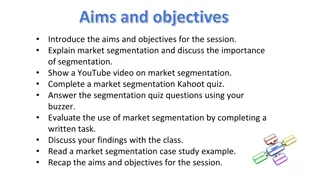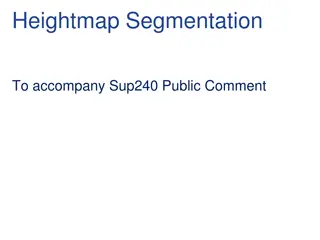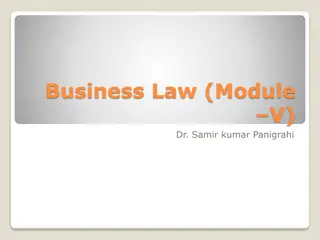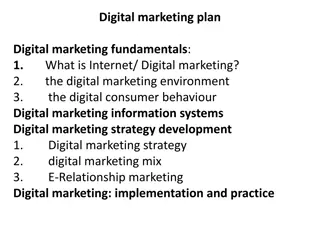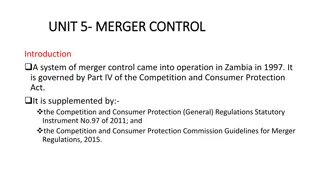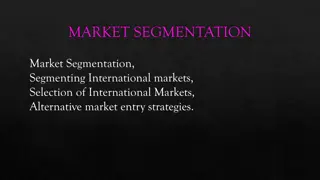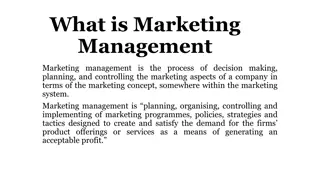Understanding Market Segmentation and Consumer Behavior in Marketing Management
Market segmentation is crucial for companies to effectively target different customer segments with tailored products and marketing strategies. By dividing the market based on characteristics and preferences, businesses can maximize customer satisfaction, improve marketing strategies, and increase profitability. This process involves identifying homogeneous customer groups using various bases such as demographic, geographic, psychographic, and behavioral factors. Product differentiation, on the other hand, focuses on creating unique product qualities to stand out from competitors. Both concepts play essential roles in successful marketing management.
Download Presentation

Please find below an Image/Link to download the presentation.
The content on the website is provided AS IS for your information and personal use only. It may not be sold, licensed, or shared on other websites without obtaining consent from the author. Download presentation by click this link. If you encounter any issues during the download, it is possible that the publisher has removed the file from their server.
E N D
Presentation Transcript
MARKETING MANAGEMENT UNIT 2: CONSUMER BEHAVIOUR AND MARKET SEGMENTATION PROF. SRIJITA DUTTA THK JAIN COLLEGE CLASS- B.COM (HONS and GEN) SEMESTER- II SEC- A and D
PART 2 MARKET SEGMENTATION
Target Marketing A company cannot serve all customers in a broad market. The customers are too numerous and diverse in their buying requirements. Many companies are embracing Target Marketing. Here, sellers distinguish the major market segments and develop products and marketing programs tailored to each. Target Marketing requires marketers to take three major steps: Market Segmentation Market Targeting Market Positioning
Market Segmentation Segmentation is all about dividing the market, by grouping together customers with similar tastes and preferences in to one segment, to serve it better. Market segmentation is the process of dividing a broad heterogeneous market consisting of existing and potential customers into a number of homogeneous sub-groups on the basis of shared characteristics of customers that is, in respect of similarities of their needs, wants, likes, dislikes, attitudes, tastes, preferences, buying pattern, buying abilities, etc.
Importance of Market Segmentation Maximizing customer satisfaction Effective marketing strategies Maximum customer satisfaction and good customer relation Essence of modern marketing Providing better service Capturing opportunities in the market Optimum utilization of resources Benefit of specialization Facing competition Increase in profitability Benefit to small-scale industries
Bases of Market Segmentation Bases of Market Segmentation On the basis of consumer characteristics On the basis of consumer responses Behavioural Demographic Geographic Psychographic Lifestyle Occasions Benefits UserStatus Age Nation Family size Personality Regions Life cycle Gender Income, Occupation Usage Rate Values States Loyalty Status Cities Education Attitude Race Buyer Readiness Stage Nationality
Distinction between Product Differentiation and Market Segmentation PRODUCT DIFFERENTIATION MARKET SEGMENTATION 1) Product Differentiation relates to making a product different in terms of product-related qualities, from those offered by competitors. 1) Market segmentation involves breaking down the potential market for a product or service into homogeneous group of customers. 2) Product differentiation focuses on imparting a distinctive identity to a product. 2) Market segmentation focuses on dividing a large market into small homogeneous sub- markets, on the basis of which marketing efforts may be directed. 3) organization to remove price competition faced by a product from its competitors by imparting a distinct identity to the product. Product differentiation equips an 3) organization to expand its target market and orient its marketing efforts on the basis on the attributes of the market segment for which a product is directed. Market segmentation equips an 4) Product differentiation emphasises on branding. 4) Market segmentation emphasises on customers, both existing and potential.
Market Targeting In Market targeting, marketers must focus their attention on targeting the market segments that are relevant to their products and likely to respond positively to their marketing strategies. Selecting the Market Segments 1) Single Segment Concentration: The strategy of targeting a single segment has worked well for some marketers, like Mercedes only concentrates on the upper income group customers. 2) Selective Specialization: Automobile manufacturer Hyundai manufactures different models of cars like the Santro, Accent, Verna etc. To cater to different segments with different level of income. 3) Product Specialisation: Some companies specialise in a particular product, like Gillette is famous worldwide for its series of shaving products. 4) Market Specialisation: Companies like the Ordinance Factories caters to the needs of the Indian defence services by manufacturing different types of arms and ammunitions for them. 5) Full Market Coverage: Only very large firms can undertake a full market coverage strategy. Examples include IBM (computer market), General Motors (vehicle market), and Coca-Cola (drink market).
Market Positioning Positioning is the act of communicating the company s offer so that it occupies a distinct and valued place in the customers mind. After a company has divided the market into segments and targeted one or more segments, it now needs to establish and communicate the products key distinctive benefits to the target group(s) in the market. According to Rooser Reeves, a company should develop an Unique Selling Proposition (USP) for each of its brand. An USP can be any special attributes about the brand like quality, price, service, value, safety provisions, technology etc. Marketers often try to promote the product on the basis of its USP. Number one positioning include bestquality , lowestprice , bestvalue , best service , safest , most advanced technology etc.




